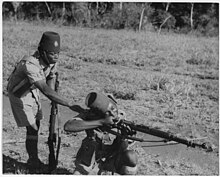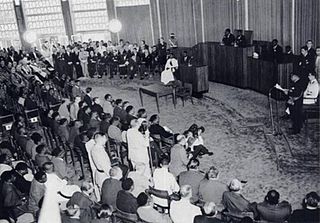This article has an unclear citation style.(June 2017) (Learn how and when to remove this template message) |
| Belgian colonial empire | |||||
| Empire colonial belge(fr) Belgische koloniën(nl) | |||||
| |||||
Flag | |||||
 Map of Belgium's colonies at their maximum extent. | |||||
| Capital | Brussels | ||||
| Languages | French served as the main colonial language, but Dutch was also used to a lesser extent Local: various | ||||
| Government | Constitutional monarchy | ||||
| History | |||||
| • | Acquisition of the Congo Free State | July 1, 1885 | |||
| • | Independence of Rwanda | July 1, 1962 | |||
Belgium controlled two colonies during its history: the Belgian Congo from 1885 to 1960 and Ruanda-Urundi from 1916 to 1962. It also had a concession in China, and was a co-administrator of the Tangier International Zone in Morocco.

Colonialism is the policy of a nation seeking to extend or retain its authority over other people or territories, generally with the aim of opening trade opportunities. The colonizing country seeks to benefit from the colonized country or land mass. In the process, colonizers imposed their religion, economics, and medicinal practices on the natives. Some argue this was a positive move toward modernization, while other scholars refute this theory as being biased and Eurocentric, noting that modernization is a concept introduced by Europeans. Colonialism is largely regarded as a relationship of domination of an indigenous majority by a minority of foreign invaders where the latter rule in pursuit of its interests.

The Belgian Congo was a Belgian colony in Central Africa from 1908 until independence in 1960. The former colony adopted its present-day name, the Democratic Republic of the Congo (DRC), in 1964.

Ruanda-Urundi was a territory in the African Great Lakes region, once part of German East Africa, which was ruled by Belgium between 1922 and 1962. Occupied by the Belgians during the East African Campaign during World War I, the territory was under Belgian military occupation from 1916 to 1922 and later became a Belgian-controlled Class B Mandate under the League of Nations from 1922 to 1945. After the disestablishment of the League and World War II, Ruanda-Urundi became a Trust Territory of the United Nations, still under Belgian control. In 1962, the mandate became independent as the two separate countries of Rwanda and Burundi.
Contents
- Background
- Leopold I's colonial ambitions
- Major possessions
- In the Congo
- Ruanda-Urundi (1916–62)
- Minor possessions
- Santo Tomás, Guatemala (1843–54)
- Tianjin Concession (1900–31)
- Isola Comacina (1919)
- See also
- Notes and references
- Footnotes
- References
- Bibliography
- External links
Roughly 98% of Belgium's overseas territory was just one colony (about 76 times larger than Belgium itself) — known as the Belgian Congo. This had originated as the personal property of the country's king, Leopold II, rather than being gained through the political or military action of the Belgian state.

The Congo Free State also known as the Independent State of the Congo was a large state in Central Africa from 1885 to 1908. It was ruled personally by Leopold II and not by the government of Belgium, of which he was the constitutional monarch. Leopold II was able to procure the region by convincing other Eurasian states at the Berlin Conference that he was involved in humanitarian and philanthropic work and would not tax trade. Via the International Association of the Congo, he was able to lay claim to most of the Congo basin. On 29 May 1885, i.e. after the closure of the Berlin Conference, the king announced that he planned to name his possessions "the Congo Free State", an appellation which was not yet used at the Berlin Conference and which officially replaced "International Association of the Congo" on 1 August 1885. The Congo Free State operated as a corporate state privately controlled by Leopold II. The state included the entire area of the present Democratic Republic of the Congo and existed from 1885 to 1908, when the government of Belgium reluctantly annexed the area.

Leopold II was King of the Belgians from 1865 to 1909. He founded and exploited the Congo Free State as a private venture and murder, torture, and other atrocities were perpetrated under his rule.
Belgians tended to refer to their overseas possessions as "the colonies" rather than "the empire", as in some other European countries. [lower-alpha 1]






















